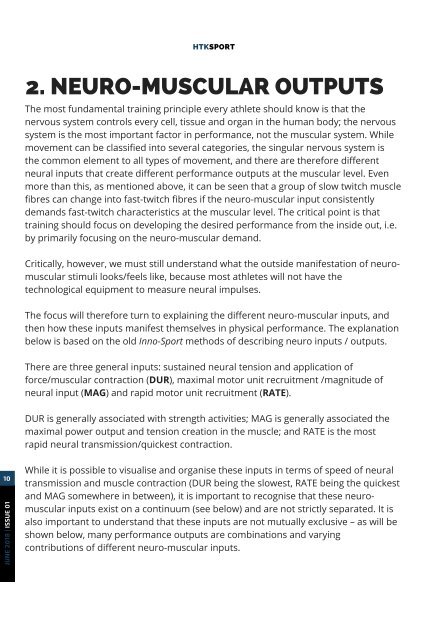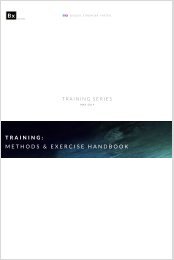Create successful ePaper yourself
Turn your PDF publications into a flip-book with our unique Google optimized e-Paper software.
HTKSPORT<br />
2. NEURO-MUSCULAR OUTPUTS<br />
The most fundamental training principle every athlete should know is that the<br />
nervous system controls every cell, tissue and organ in the human body; the nervous<br />
system is the most important factor in performance, not the muscular system. While<br />
movement can be classified into several categories, the singular nervous system is<br />
the common element to all types of movement, and there are therefore different<br />
neural inputs that create different performance outputs at the muscular level. Even<br />
more than this, as mentioned above, it can be seen that a group of slow twitch muscle<br />
fibres can change into fast-twitch fibres if the neuro-muscular input consistently<br />
demands fast-twitch characteristics at the muscular level. The critical point is that<br />
training should focus on developing the desired performance from the inside out, i.e.<br />
by primarily focusing on the neuro-muscular demand.<br />
Critically, however, we must still understand what the outside manifestation of neuromuscular<br />
stimuli looks/feels like, because most athletes will not have the<br />
technological equipment to measure neural impulses.<br />
The focus will therefore turn to explaining the different neuro-muscular inputs, and<br />
then how these inputs manifest themselves in physical performance. The explanation<br />
below is based on the old Inno-Sport methods of describing neuro inputs / outputs.<br />
There are three general inputs: sustained neural tension and application of<br />
force/muscular contraction (DUR), maximal motor unit recruitment /magnitude of<br />
neural input (MAG) and rapid motor unit recruitment (RATE).<br />
DUR is generally associated with strength activities; MAG is generally associated the<br />
maximal power output and tension creation in the muscle; and RATE is the most<br />
rapid neural transmission/quickest contraction.<br />
10<br />
JUNE 2018 | ISSUE 01<br />
While it is possible to visualise and organise these inputs in terms of speed of neural<br />
transmission and muscle contraction (DUR being the slowest, RATE being the quickest<br />
and MAG somewhere in between), it is important to recognise that these neuromuscular<br />
inputs exist on a continuum (see below) and are not strictly separated. It is<br />
also important to understand that these inputs are not mutually exclusive – as will be<br />
shown below, many performance outputs are combinations and varying<br />
contributions of different neuro-muscular inputs.




